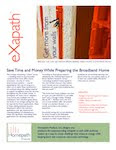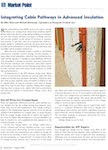In this age, it seems we’re drawn into a world of digi-speak, constantly inundated with impressive sounding jargon that can leave us baffled. Couple this with sustainability, and the subject matter quickly overwhelms.
In a recent post, I marveled at the notion of using fiber optics within the home. Intel’s announcement about its “Light Peak” technology buoyed a significant market buzz.
Their claim of a 10 Gigabit per second (Gb/s) data rate is surely impressive...and technically achievable...
...but what does this really mean for us consumers?
To grasp it, we start by defining a term that entered the lexicon in the late 1940’s. Bit. I consulted with Merriam-Webster and learned that, in computer speak, a binary digit (bit) is a unit of information expressed as either a 0 or 1, a yes or no. It follows that a bit rate is the number of bits per second that can be transmitted in a digital system. A Byte is equal to 8 bits. So, there’s our baseline. (Click image for a "bit" of fun - pdf download)
Times change us
Today, I use a digital SLR camera. It works well, it is fairly new, but seriously out of date. Such is technology...and so much for that 20 MB hard drive...one photo on my adolescent camera takes up about 3 MB...therefore my venerable Mac SE would struggle to store just 7 photos. It’s comforting to know that the memory card for the camera holds about 700 photos. My latest computer holds more...and I no longer need to use caustic chemicals, paper, and physical storage for them. A “bit” of sustainability, perhaps?
Do you like Blu-ray?
Blu-ray is the latest consumer electronics video technology making the rounds. When High Definition (HD) reared its head a need to dramatically increase the amount of data stored on a plastic disc rose along with it. Blu-ray gets its name by making use of a shorter wavelength, 405 nanometer blue-violet laser, to squeeze more digital storage on those discs. So how much can one hold?
Well, first we need to make the leap from Mega to Giga. Mega, as used above, indicates million. So a Megabyte (MB) of storage is enough to hold a million bytes. Giga means billion, or one-thousand times greater than Mega...a dual-layer Blu-ray disc holds about 50 Gigabytes (GB). A whole lot.
Improved storage capacity helps. It means more intricate gaming, richer HD movies, HD-3D feature presentations, high quality audio files, etc. We all find ways to benefit from these technologies.
We’ve come a long way...largely resulting from technological development and superb engineering. It is nice being able to take these things for granted.
We’re social, we share
If you’re reading this blog, chances are you’re a regular on the internet, you participate in social media, and are accustomed to sharing your digital stuff. So, when we have the latest killer app...as social creatures...we get the urge to share it.
Whether you’re streaming music, sharing a photo, or watching football on the web...data rate is all important to you. The faster the rate the better the quality of sound or music, and the quicker the files transit from the source device to the receiving device. Simple stuff really...the amazing part is how far this portion of the digital world has come...but we are really only at the leading edge of where it will go.
Rates are the rage
Have you experienced that sense of frustration while using services like YouTube? You know, so easy to share, but the quality just doesn’t compare to your Blu-ray gear? Is it reasonable to expect better quality through web services like YouTube, NetFlix, Blockbuster, Amazon, or Wal-Mart. You bet!
Together, science and industry have solved the immediate issues related to data storage, computing power, and high resolution viewing. Now, it’s about moving data from place-to-place fast enough to support the quality we’ve come to expect.
We use external (public) networks to connect our homes to the internet. Terms like Dial-Up, DSL, Cable, and Fiber-to-the-Home (FTTH) describe these. Once the signal enters the home we use “private” networks, linking computers and consumer electronics gadgets to each other. These are often described as Ethernet, Fast Ethernet, Gigabit Ethernet, and WiFi. The modem is the equipment sitting between them doing yeoman’s work to translate. It’s what allows the outside and inside networks to converse. Whether external or private, the names designate the speed at which they transfer data.
A disconnect. We enjoy the sound and vision experience delivered through Blu-ray equipment. We also like the convenience of content sharing through services like YouTube...but still we come away somewhat frustrated with the lack of rich viewing experience. Why?
Well, by today’s standards, asking the network to transfer a Blu-ray file efficiently is like asking my old Mac SE to serve up an entire photo library, while playing music, surfing the web, and processing words. The desire is there but the hardware isn’t. Sorry old Mac SE..to the dust bin...errrrr, I mean recycler.
Who has hours to wait?
Perspective...take a Blu-ray file. For arguments sake, assume it has a size of 25 GB...that’s roughly 200 billion bits. Huge by today’s standards...likely relegated to “small” five years from now. If you crunch the numbers, sending that by Dial-Up would take...get this...42 days.
Now try the same thing, but use today’s enhanced web services like Verizon FiOS®, AT&T U-verse℠ or Comcast®. The data rates vary by service, but all enable you to transfer the file in a matter of hours. But still who has hours to wait?
Across the US, a movement toward faster broadband is afoot. The players listed above, along with many others, are investing in new plant and equipment to address this bandwidth bottleneck.
In a few short years, transferring the same file on the public network will happen in a matter of seconds. This is leading to new business models by NetFlix, Blockbuster, Amazon and Wal-Mart who see a future where customers shift away from “order online/wait for delivery” to a more sustainable, and profitable, approach where ordering and delivery are instantaneous. There is no packaging to dispose of, far less fuel consumed, instant gratification. Sustainability we can all participate in. What’s not to like?
The shifting bottleneck
The private network...the piece we control...will need to accommodate these changes. Homes are built to last...but are significantly outpaced by technologies they’re asked to adopt. When planning a renovation or a new home focus on energy conservation and use sustainable practices, but consider the technology changes the structure will be asked to make.
Avoid violating the insulation envelope when moving, adding to, or upgrading cables to support new consumer electronics. Plan for periodic upgrades to the wiring and build for change. Homepath Products is bridging the gap between broadband and home construction™ with the eXapath™ in-wall cable pathway system, preparing homes to take full advantage of what the future may hold.
That’s value that doesn’t bite.







.jpg)


No comments:
Post a Comment